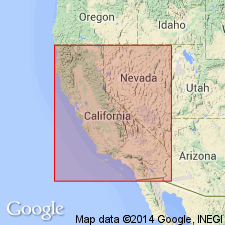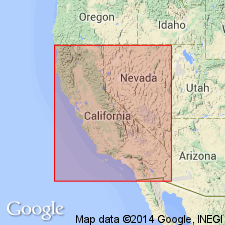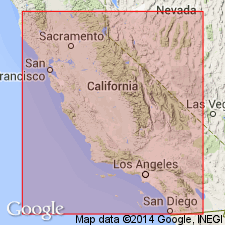
- Usage in publication:
-
- German Rancho Formation
- Modifications:
-
- Named
- Dominant lithology:
-
- Arkose
- AAPG geologic province:
-
- California Coast Ranges province
Summary:
Paleocene and Eocene section of "Gualala group" in Gualala area of northwestern CA named German Rancho Formation. [no type designated] Consists predominantly of gray-white arkose rich in potassium feldspar. Overlies Gualala Formation (herein restricted to Cretaceous section).
Source: GNU records (USGS DDS-6; Menlo GNULEX).

- Usage in publication:
-
- strata of German Rancho
- Modifications:
-
- Biostratigraphic dating
- AAPG geologic province:
-
- Northern Coast Range province
Summary:
strata of German Rancho. [Name German Rancho "Formation" not used.] Gualala Group of Weaver (1943) divided into three mappable units (ascending), informally called: strata of Stewarts Point, strata of Anchor Bay, and strata of German Rancho. Strata of German Rancho consist of gray-white K-feldspar arkose with interbedded gray-black mudstone and locally abundant conglomerate. Thickness 10,000 feet in area northwest of Anchor Bay. Incomplete section near Salt Point is perhaps 20,000 feet thick. Conformably overlies strata of Anchor Bay. At Iversen landing underlies Iversen Basalt of Weaver (1944) and lower Miocene Skooner Gulch Formation (Addicott, in press). Fossils sparse. Includes gastropod CAMPANILE GREENELLUM Hanna and Hertlein and largely arenaceous Paleocene and Eocene foraminifers. Age is considered Paleocene to at least middle Eocene.
Source: Modified from GNU records (USGS DDS-6; Menlo GNULEX).

- Usage in publication:
-
- German Rancho Formation*
- Modifications:
-
- Age modified
- AAPG geologic province:
-
- California Coast Ranges province
Summary:
Sparse "Martinez" megafossils are present 2,400 ft above base and "Capay" or "Domengine" megafossils are present in upper part of formation; top part may be as young as late Eocene.
Source: GNU records (USGS DDS-6; Menlo GNULEX).
For more information, please contact Nancy Stamm, Geologic Names Committee Secretary.
Asterisk (*) indicates published by U.S. Geological Survey authors.
"No current usage" (†) implies that a name has been abandoned or has fallen into disuse. Former usage and, if known, replacement name given in parentheses ( ).
Slash (/) indicates name conflicts with nomenclatural guidelines (CSN, 1933; ACSN, 1961, 1970; NACSN, 1983, 2005, 2021). May be explained within brackets ([ ]).

